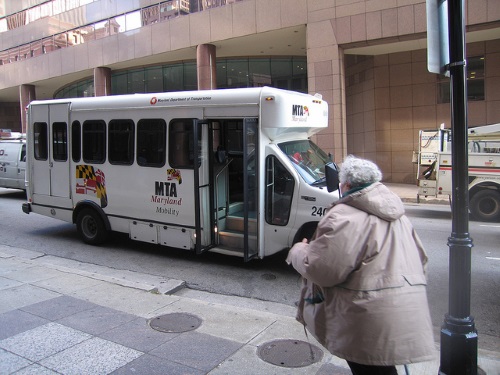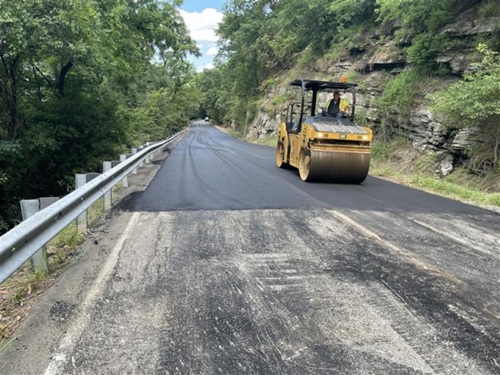A poll conducted by the National Aging and Disability Transportation Center indicates that 68 percent of older adults and 79 percent of younger adults with disabilities believe locating “alternative transportation” if they could not drive would be “very difficult” or “somewhat difficult,” as both overwhelming said driving their own vehicle is the primary way they get around (82 percent and 66 percent, respectively) followed by getting a ride with family or friends (58 percent and 74 percent).
[Above photo by the Maryland Transit Administration.]
The results of the NADTC poll – released in a 32-page report on Dec. 6 – also found that just 15 percent of older adults and 32 percent of younger adults with disabilities use public transportation services.
“Access to transportation is key to support the health and well-being of older adults and ensure their ability to age in place and have a high quality of life in their community,” noted Virginia Dize, co-director of NADTC and transportation program director for the National Association of Area Agencies on Aging.

“Yet this survey reveals that access to transportation that meets their needs is clearly a major challenge,” she said in a statement. “While local transportation options do exist, older adults and people with disabilities do not know about them or have access to them.
The NADTC – a non-profit organization funded through a cooperative agreement of Easterseals, the National Association of Area Agencies on Aging, the U.S Department of Transportation, and Federal Transit Administration – added that with more than one in 5 Americans older than age 65 not driving, demand for transportation is steadily increasing as the boomer population continues to grow. Given that 600,000 people stop driving every year, there is no end to the challenge in sight, the group said.
Other findings from NADTC’s poll include:
- Fewer people living in rural areas or small towns say the transportation alternatives available to them are good. Only 49 percent of older adults and 45 percent of younger adults with disabilities in small towns say they have good alternatives to driving, compared to 62 percent of older adults and 75 percent of younger adults with disabilities in large cities or suburbs.
- Those who do not drive face many barriers, including access to affordable transportation alternatives. Access and availability (40 percent older adults, 38 percent younger adults with disabilities) and affordability (12 percent, 20 percent) stand out as barriers, particularly for those without a caregiver; and only about a quarter say they have excellent options.
- There is no single “go-to” resource for alternative transportation options. Some 43 percent of older adults and 48 percent of people living with disabilities rely on family, friends or colleagues for information and many (24 percent and 31 percent) search on the computer, NADTC found, with organizations that serve older adults or people with disabilities and transportation agencies are “less frequently consulted.”
State departments of transportation are stepping up efforts to help change that, especially as data indicates older drivers can be higher risks of a crash.

The Pennsylvania Department of Transportation, for one, recently co-hosted an older driver safety event on Dec. 4 with the Pennsylvania Department of Aging, noting that 22 percent of Pennsylvania’s 8.9 million licensed drivers are 65 and older. In 2017, there were 21,319 crashes involving a driver 65 and older, resulting in 270 fatalities. This represents nearly 17 percent of the total crashes in Pennsylvania and nearly 24 percent of the fatalities, explained PennDOT Secretary Leslie Richards in a statement.
“It’s essential for older drivers and their family members to speak openly about what they’ll do when it is time to hang up the keys for safety’s sake,” she said, noting that crash rates increase as drivers age because these drivers may have health conditions or take medications that negatively affect their driving abilities, and this can put them and other road users at risk.

PennDOT noted that there is a “growing network of services” dedicated to keeping older adults mobile, safe, and engaged in their community. In fiscal year 2016-2017, more than 140,000 older Pennsylvanians accessed transportation services through their local Area Agencies on Aging, totaling more than 1.6 million rides, the agency said.
Fritzi Schreffler, the safety press officer for PennDOT District 8, recently highlighted one such service called “CarFit,” an educational program created by the American Society on Aging and developed with AAA, AARP, and the American Occupational Therapy Association, designed to help older drivers find out how well they currently fit their personal vehicle, to learn how they can improve their fit, and to promote conversations about driver safety and community mobility.
The Texas Department of Transportation is beginning to craft a multi-million-dollar transportation plan aimed at helping older Texans get around without driving. According to a recent news story, the agency plans to hold a series of statewide “listening sessions” to address the mobility problems facing older adults, while $6 million will be divided into areas where current transportation is “unavailable” or “failing” for them.
 Nation
Nation


